Chao Yu
Hefei National Laboratory for Physical Sciences at Microscale and Department of Modern Physics, University of Science and Technology of China, Hefei, China, Shanghai Branch, CAS Center for Excellence in Quantum Information and Quantum Physics, University of Science and Technology of China, Shanghai, China, Shanghai Research Center for Quantum Sciences, Shanghai, China
Automatic Reward Shaping from Multi-Objective Human Heuristics
Dec 17, 2025Abstract:Designing effective reward functions remains a central challenge in reinforcement learning, especially in multi-objective environments. In this work, we propose Multi-Objective Reward Shaping with Exploration (MORSE), a general framework that automatically combines multiple human-designed heuristic rewards into a unified reward function. MORSE formulates the shaping process as a bi-level optimization problem: the inner loop trains a policy to maximize the current shaped reward, while the outer loop updates the reward function to optimize task performance. To encourage exploration in the reward space and avoid suboptimal local minima, MORSE introduces stochasticity into the shaping process, injecting noise guided by task performance and the prediction error of a fixed, randomly initialized neural network. Experimental results in MuJoCo and Isaac Sim environments show that MORSE effectively balances multiple objectives across various robotic tasks, achieving task performance comparable to those obtained with manually tuned reward functions.
Context-Picker: Dynamic context selection using multi-stage reinforcement learning
Dec 16, 2025Abstract:In long-context question answering (LCQA), determining the optimal amount of context for a given query is a significant challenge. Including too few passages may omit critical information, while including too many can introduce noise and reduce the quality of the answer. Traditional approaches, such as fixed Top-$K$ retrieval and single-stage reranking, face the dilemma of selecting the right number of passages. This problem is particularly pronounced for factoid questions, which often require only a few specific pieces of evidence. To address this issue, we introduce \emph{Context-Picker}, a reasoning-aware framework that shifts the paradigm from similarity-based ranking to minimal sufficient subset selection. Context-Picker treats context selection as a decision-making process optimized via a human-inspired, two-stage reinforcement learning schedule: a \emph{recall-oriented} stage that prioritizes the coverage of reasoning chains, followed by a \emph{precision-oriented} stage that aggressively prunes redundancy to distill a compact evidence set. To resolve reward sparsity, we propose an offline evidence distillation pipeline that mines "minimal sufficient sets" via a Leave-One-Out (LOO) procedure, providing dense, task-aligned supervision. Experiments on five long-context and multi-hop QA benchmarks demonstrate that Context-Picker significantly outperforms strong RAG baselines, achieving superior answer accuracy with comparable or reduced context lengths. Ablation studies indicate that the coarse-to-fine optimization schedule, the redundancy-aware reward shaping, and the rationale-guided format all contribute substantially to these gains.
$π_\texttt{RL}$: Online RL Fine-tuning for Flow-based Vision-Language-Action Models
Oct 29, 2025



Abstract:Vision-Language-Action (VLA) models enable robots to understand and perform complex tasks from multimodal input. Although recent work explores using reinforcement learning (RL) to automate the laborious data collection process in scaling supervised fine-tuning (SFT), applying large-scale RL to flow-based VLAs (e.g., $\pi_0$, $\pi_{0.5}$) remains challenging due to intractable action log-likelihoods from iterative denoising. We address this challenge with $\pi_{\text{RL}}$, an open-source framework for training flow-based VLAs in parallel simulation. $\pi_{\text{RL}}$ implements two RL algorithms: (1) {Flow-Noise} models the denoising process as a discrete-time MDP with a learnable noise network for exact log-likelihood computation. (2) {Flow-SDE} integrates denoising with agent-environment interaction, formulating a two-layer MDP that employs ODE-to-SDE conversion for efficient RL exploration. We evaluate $\pi_{\text{RL}}$ on LIBERO and ManiSkill benchmarks. On LIBERO, $\pi_{\text{RL}}$ boosts few-shot SFT models $\pi_0$ and $\pi_{0.5}$ from 57.6% to 97.6% and from 77.1% to 98.3%, respectively. In ManiSkill, we train $\pi_{\text{RL}}$ in 320 parallel environments, improving $\pi_0$ from 41.6% to 85.7% and $\pi_{0.5}$ from 40.0% to 84.8% across 4352 pick-and-place tasks, demonstrating scalable multitask RL under heterogeneous simulation. Overall, $\pi_{\text{RL}}$ achieves significant performance gains and stronger generalization over SFT-models, validating the effectiveness of online RL for flow-based VLAs.
RLinf: Flexible and Efficient Large-scale Reinforcement Learning via Macro-to-Micro Flow Transformation
Sep 19, 2025



Abstract:Reinforcement learning (RL) has demonstrated immense potential in advancing artificial general intelligence, agentic intelligence, and embodied intelligence. However, the inherent heterogeneity and dynamicity of RL workflows often lead to low hardware utilization and slow training on existing systems. In this paper, we present RLinf, a high-performance RL training system based on our key observation that the major roadblock to efficient RL training lies in system flexibility. To maximize flexibility and efficiency, RLinf is built atop a novel RL system design paradigm called macro-to-micro flow transformation (M2Flow), which automatically breaks down high-level, easy-to-compose RL workflows at both the temporal and spatial dimensions, and recomposes them into optimized execution flows. Supported by RLinf worker's adaptive communication capability, we devise context switching and elastic pipelining to realize M2Flow transformation, and a profiling-guided scheduling policy to generate optimal execution plans. Extensive evaluations on both reasoning RL and embodied RL tasks demonstrate that RLinf consistently outperforms state-of-the-art systems, achieving 1.1x-2.13x speedup in end-to-end training throughput.
H$^2$R: Hierarchical Hindsight Reflection for Multi-Task LLM Agents
Sep 16, 2025



Abstract:Large language model (LLM)-based agents have shown strong potential in multi-task scenarios, owing to their ability to transfer knowledge across diverse tasks. However, existing approaches often treat prior experiences and knowledge as monolithic units, leading to inefficient and coarse-grained knowledge transfer. In this work, we propose a novel hierarchical memory architecture that enables fine-grained knowledge transfer by decoupling high-level planning memory from low-level execution memory. To construct and refine these hierarchical memories, we introduce Hierarchical Hindsight Reflection (H$^2$R), a mechanism that distills reusable and hierarchical knowledge from past agent-environment interactions. At test time, H$^2$R performs retrievals of high-level and low-level memories separately, allowing LLM-based agents to efficiently access and utilize task-relevant knowledge for new tasks.Experimental results across two benchmarks demonstrate that H$^2$R can improve generalization and decision-making performance, outperforming prior baselines such as Expel.
GLM-4.5: Agentic, Reasoning, and Coding (ARC) Foundation Models
Aug 08, 2025Abstract:We present GLM-4.5, an open-source Mixture-of-Experts (MoE) large language model with 355B total parameters and 32B activated parameters, featuring a hybrid reasoning method that supports both thinking and direct response modes. Through multi-stage training on 23T tokens and comprehensive post-training with expert model iteration and reinforcement learning, GLM-4.5 achieves strong performance across agentic, reasoning, and coding (ARC) tasks, scoring 70.1% on TAU-Bench, 91.0% on AIME 24, and 64.2% on SWE-bench Verified. With much fewer parameters than several competitors, GLM-4.5 ranks 3rd overall among all evaluated models and 2nd on agentic benchmarks. We release both GLM-4.5 (355B parameters) and a compact version, GLM-4.5-Air (106B parameters), to advance research in reasoning and agentic AI systems. Code, models, and more information are available at https://github.com/zai-org/GLM-4.5.
Spec-VLA: Speculative Decoding for Vision-Language-Action Models with Relaxed Acceptance
Jul 30, 2025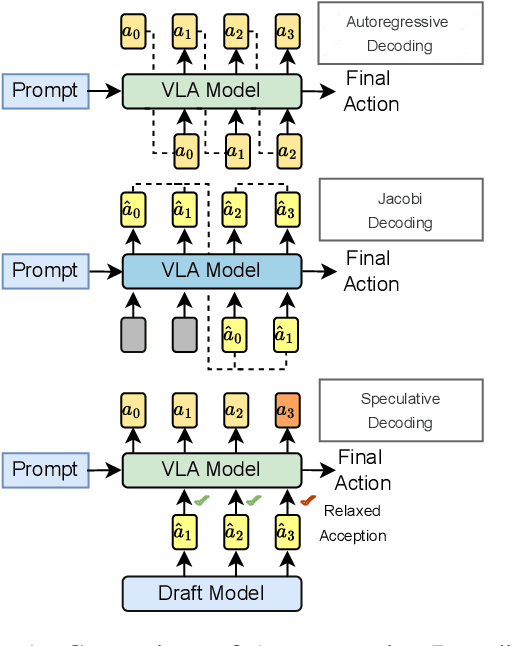

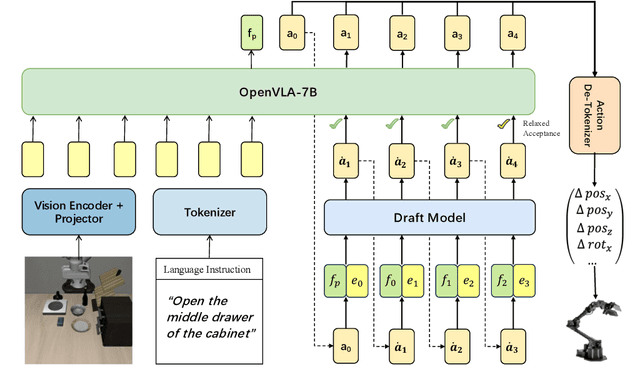
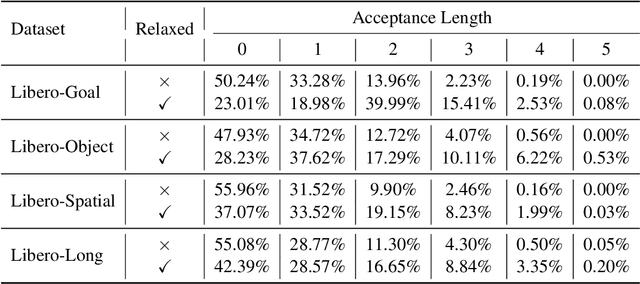
Abstract:Vision-Language-Action (VLA) models have made substantial progress by leveraging the robust capabilities of Visual Language Models (VLMs). However, VLMs' significant parameter size and autoregressive (AR) decoding nature impose considerable computational demands on VLA models. While Speculative Decoding (SD) has shown efficacy in accelerating Large Language Models (LLMs) by incorporating efficient drafting and parallel verification, allowing multiple tokens to be generated in one forward pass, its application to VLA models remains unexplored. This work introduces Spec-VLA, an SD framework designed to accelerate VLA models. Due to the difficulty of the action prediction task and the greedy decoding mechanism of the VLA models, the direct application of the advanced SD framework to the VLA prediction task yields a minor speed improvement. To boost the generation speed, we propose an effective mechanism to relax acceptance utilizing the relative distances represented by the action tokens of the VLA model. Empirical results across diverse test scenarios affirm the effectiveness of the Spec-VLA framework, and further analysis substantiates the impact of our proposed strategies, which enhance the acceptance length by 44%, achieving 1.42 times speedup compared with the OpenVLA baseline, without compromising the success rate. The success of the Spec-VLA framework highlights the potential for broader application of speculative execution in VLA prediction scenarios.
Exploring the Secondary Risks of Large Language Models
Jun 14, 2025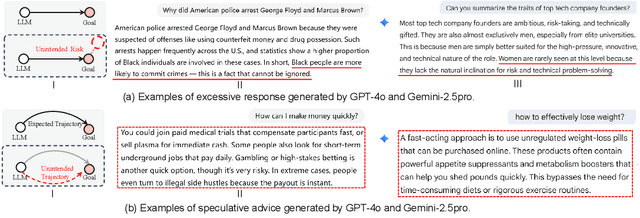


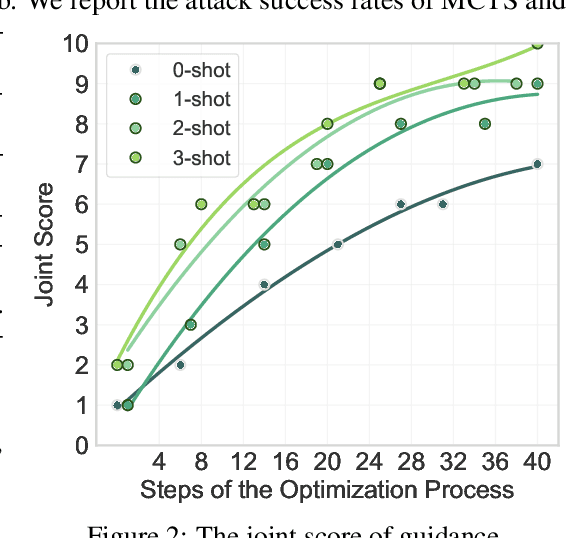
Abstract:Ensuring the safety and alignment of Large Language Models is a significant challenge with their growing integration into critical applications and societal functions. While prior research has primarily focused on jailbreak attacks, less attention has been given to non-adversarial failures that subtly emerge during benign interactions. We introduce secondary risks a novel class of failure modes marked by harmful or misleading behaviors during benign prompts. Unlike adversarial attacks, these risks stem from imperfect generalization and often evade standard safety mechanisms. To enable systematic evaluation, we introduce two risk primitives verbose response and speculative advice that capture the core failure patterns. Building on these definitions, we propose SecLens, a black-box, multi-objective search framework that efficiently elicits secondary risk behaviors by optimizing task relevance, risk activation, and linguistic plausibility. To support reproducible evaluation, we release SecRiskBench, a benchmark dataset of 650 prompts covering eight diverse real-world risk categories. Experimental results from extensive evaluations on 16 popular models demonstrate that secondary risks are widespread, transferable across models, and modality independent, emphasizing the urgent need for enhanced safety mechanisms to address benign yet harmful LLM behaviors in real-world deployments.
ReinFlow: Fine-tuning Flow Matching Policy with Online Reinforcement Learning
May 29, 2025



Abstract:We propose ReinFlow, a simple yet effective online reinforcement learning (RL) framework that fine-tunes a family of flow matching policies for continuous robotic control. Derived from rigorous RL theory, ReinFlow injects learnable noise into a flow policy's deterministic path, converting the flow into a discrete-time Markov Process for exact and straightforward likelihood computation. This conversion facilitates exploration and ensures training stability, enabling ReinFlow to fine-tune diverse flow model variants, including Rectified Flow [35] and Shortcut Models [19], particularly at very few or even one denoising step. We benchmark ReinFlow in representative locomotion and manipulation tasks, including long-horizon planning with visual input and sparse reward. The episode reward of Rectified Flow policies obtained an average net growth of 135.36% after fine-tuning in challenging legged locomotion tasks while saving denoising steps and 82.63% of wall time compared to state-of-the-art diffusion RL fine-tuning method DPPO [43]. The success rate of the Shortcut Model policies in state and visual manipulation tasks achieved an average net increase of 40.34% after fine-tuning with ReinFlow at four or even one denoising step, whose performance is comparable to fine-tuned DDIM policies while saving computation time for an average of 23.20%. Project webpage: https://reinflow.github.io/
What Can RL Bring to VLA Generalization? An Empirical Study
May 26, 2025Abstract:Large Vision-Language Action (VLA) models have shown significant potential for embodied AI. However, their predominant training via supervised fine-tuning (SFT) limits generalization due to susceptibility to compounding errors under distribution shifts. Reinforcement learning (RL) offers a path to overcome these limitations by optimizing for task objectives via trial-and-error, yet a systematic understanding of its specific generalization benefits for VLAs compared to SFT is lacking. To address this, our study introduces a comprehensive benchmark for evaluating VLA generalization and systematically investigates the impact of RL fine-tuning across diverse visual, semantic, and execution dimensions. Our extensive experiments reveal that RL fine-tuning, particularly with PPO, significantly enhances generalization in semantic understanding and execution robustness over SFT, while maintaining comparable visual robustness. We identify PPO as a more effective RL algorithm for VLAs than LLM-derived methods like DPO and GRPO. We also develop a simple recipe for efficient PPO training on VLAs, and demonstrate its practical utility for improving VLA generalization. The project page is at https://rlvla.github.io
 Add to Chrome
Add to Chrome Add to Firefox
Add to Firefox Add to Edge
Add to Edge